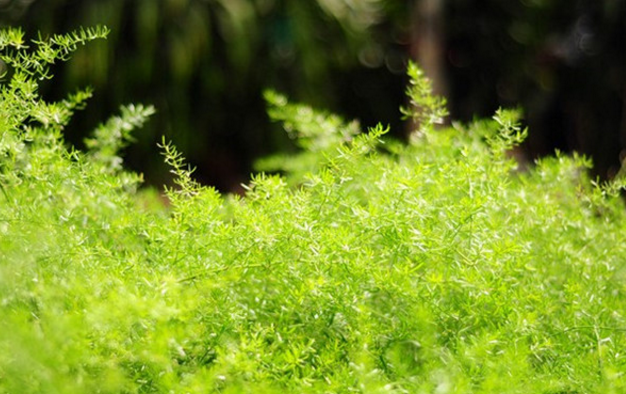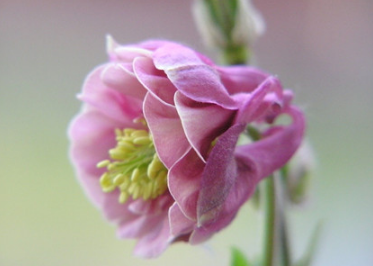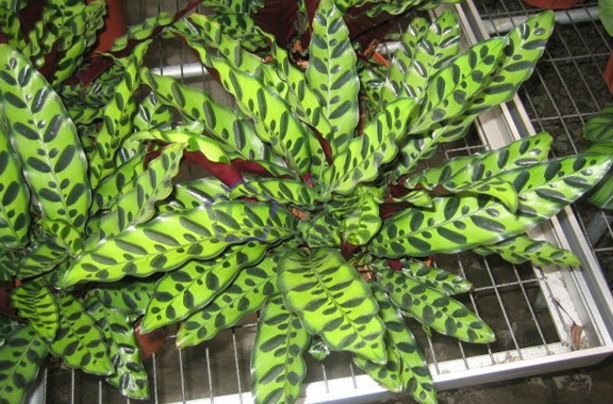Where can the breeding methods and matters needing attention of Tianmen winter be put?
Asparagus, also known as asparagus, is a perennial semi-vine green herb of Liliaceae. With fusiform roots, leaflike branches linear, clustered, flowers white or reddish, berries bright red. It is a kind of perennial herb, which is widely distributed in our country. Radix asparagi has a certain medicinal value.

Culture methods and matters needing attention of Tianmen winter
1. Soil requirements of Tianmen winter
Like the warm and humid environment, like the sun, resistant to semi-shade, afraid of direct light. It is advisable to loosen the sandy loam with fertile soil and good drainage. In the north, the cultivation of Tianmen winter is more than the middle and late April to change the basin. When changing the basin, cut off some of the old roots and add the culture soil mixed with 4 parts of rotten leaf soil, 4 parts of garden soil and 2 parts of river SARS.
2. The watering method of Tianmen winter
Water thoroughly every 2-3 days in spring. At this time, if the air is dry, it is necessary to spray water on the plant every day to sprinkle water on the ground around the maintenance site; in summer, spray water every 2-3 days to increase air humidity. Tianmen winter is fleshy root, afraid of waterlogging, usually watering should not be too much; water permeable once a day in summer.
3. Fertilization methods of Tianmen winter.
The period of vigorous growth is from May to September, and rotten cake fertilizer and water can be applied every 15 to 20 days. If the indoor light is insufficient, it should be kept outdoors for a period of time in spring and autumn; in winter, where the indoor light is sufficient, the room temperature should be kept above 5 ℃, water should be watered every 10 to 15 days, and branches and leaves should be sprayed and washed every 3 to 5 days.
4. The breeding method of Tianmeng.
Tianmen winter reproduction can be combined with the change of pot in spring, the mother plant should be more than 3 years old, when dividing, the mother plant should be taken out of the pot, according to the size of the plant cluster. Several pots were planted, watered thoroughly and placed in the semi-shade for 15 days. the seeds matured at the end of December, soaked in water after harvest, rubbed the peel and dried in the sun. Spring sowing, the indoor temperature should not be lower than 15 ℃, it can germinate in a month, and the seedlings will be planted separately when they are about 4ml 5cm long, with several plants in each pot.
Where can I put it?
Tianmen winter, also known as Wuzhu, it is a beautiful green plant, the leaves are slender, dense, green, very lovely. It is very suitable for indoor display. If potted Tianmen winter, not pruning, but let it grow naturally, then the main branch can at least extend a few meters, so that the living environment can be embellished more fresh and elegant.
In indoor breeding Tianmen winter, you can put it on the windowsill, and then let the branches and leaves extend freely on the windowsill, you can make the windowsill adorned green and moving. The windowsill has a fresh green, and the whole family will feel refreshed.
In indoor breeding Tianmen winter, you can also use flowerpots to raise Tianmen winter inside, and then hang it in the living room or on the walls of other places, so that the branches of Tianmen winter gently droop, appear to be particularly elegant, and there will be a sense of beauty of hanging plants.
The function and implication of putting Tianmeng in the home
Tianmen winter, thick branches and leaves, leaves look like pine needles, very pleasing to the eye. It symbolizes the prosperity of the career and the prosperity of wealth. Putting such a beautiful plant at home is a good wish for your career and wealth.
Tianmen winter also has the role of purifying the air, it can purify the carbon dioxide in the air, raise it indoors, but also play an unexpected effect.
Breeding methods and matters needing attention of Foxtail Tianmeng
Latin name Asparagus densifloras
Also known as fox tail Wu bamboo
The plant kingdom.
Phylum angiosperm
Monocotyledon class
Liliformes
Liliaceae
Belong to Tianmen winter genus
Fox tail Tianmendong gets its name because the plant is similar to the tail of a fox. it is a perennial herb evergreen vine foliage plant of Liliaceae and Tianmeng, a famous ornamental plant. The roots of asparagus are slightly fleshy, the stems are soft and tufted, and the elongated stems are climbing; the common to green leaves are not real leaves, but leaflike branches, which degenerate into scales, light brown, and grow at the base of leafy branches; leafy branches are slender and clustered, showing triangular horizontal expansion of feathers; leafy branches have 6-13 branchlets per piece, branchlets 3-6 mm long, green.
1. Basic information
Plant name: Fox tail Tianmenong, fox tail Wu bamboo
Scientific name: Aspragus densiflorus cv.Myers
Latin name: Asparagus densifloras
Family: Liliaceae
Genus: Ophiopogon
2. Morphological characteristics.
Plants clump, stems grow erect, 30 cm to 60 cm tall, slightly curved, but not drooping; leaves small and scaly or stalked, 3 to 4 radiate, leaves and stems are bright green; florets white, fragrant; berries globular, initially green, bright red after maturity, shiny epidermis, black seeds inside. Fox tail Tianmen winter is often used for foliage flower cultivation, can be arranged in halls, bedrooms, balconies and other places, quite distinctive.
3. Growth habits
The fox tail Tianmendong is native to South Africa. It likes a warm and humid environment and can grow normally in semi-overcast and sunny places. Can be placed in a bright indoor light for a long time to watch, April to October can be put in outdoor maintenance, summer high temperature should be appropriate shade to prevent hot sun exposure. The suitable temperature for growth is 15 ℃ to 25 ℃. During the growth period, the root system should be fully watered, because the root system is strong and developed, it has more nutrients and water, and it has a certain ability to resist drought. Occasionally forgetting watering will not have a great impact on plant growth, but it can not be long-term lack of water, otherwise it will cause leaves to turn yellow and fall off, and the air is too dry is also an important reason for leaf yellowing and shedding, so it is necessary to spray water to the plants regularly. To keep the air moist and make the leaves green and pleasant.
4. Cultivation techniques
The fox tail Tianmen likes fertilizer in winter, and the mature thin liquid fertilizer is applied once a week in the growing season. Sufficient sunshine is required in winter. When the lowest temperature is not lower than 12 ℃, it can be watered and fertilized normally to make the plant continue to grow. If watering is controlled, fertilization is stopped and the plant is dormant, 8 ℃ to 10 ℃ can survive the winter. The basin is changed once a year in early spring. When changing the basin, part of the tuberous roots should be cut off, and the stems with too many yellow leaves or too old stems should be cut off from the base to promote the germination of healthy and beautiful new plants. The basin soil should be loose and fertile, and mixed with rotten cake fertilizer as base fertilizer. When planting pot soil is not too full, should leave more basin edge, lest the root system grow too fast, make the root protruding out of the basin surface, affecting watering.
The reproduction of fox tail Tianmendong can be combined with changing pots for ramets. It can also be sowed and propagated, and the seeds should be sown as they are picked, otherwise the germination rate will be affected.
Culture methods and matters needing attention of asparagus [figure]
Asparagus, also known as Pinus elliottii, Phyllostachys pubescens, Phyllostachys pubescens and so on, is a kind of climbing plant, the plant is several meters high. As asparagus is a potted foliage plant, its ornamental value is very high, can be put in the living room, study and other places for breeding, and it can also purify the air. The root of asparagus is a kind of medicine, which has the function of moistening lung and relieving cough for acute tracheitis. Today, let's take a look at the breeding methods and precautions of the article. The pot soil of asparagus culture method asparagus likes to grow in loose, fertile, well-drained sandy loam rich in humus, so when breeding, garden soil, rotten leaves, compost soil and sand can be mixed in accordance with the proportion of 4RV 2RU 2RU 1 to cultivate asparagus, and it is necessary to change soil and fertilize it regularly during culture. If too much fertilizer is applied, it is easy to burn roots, so it is necessary to pour the pot to remove the fertilizer, irrigate the soil with clean water, and then put it into the new culture soil for culture. The watering method of asparagus is a kind of drought-resistant plant, but if it is watered too much, it is easy to cause its roots to rot. Too little watering will lead to the withering and yellowing of its leaf tips. Therefore, in the process of watering, it must be watered according to the weather and the drought of the basin soil. Especially in the case of hot and dry weather, it is necessary to spray foliage with water to humidify and cool down. In winter, it is necessary to water less. The demand for fertilizer of asparagus is not great, but it can not be short of fertilizer, because it is limited by pot soil culture, it is necessary to replenish nutrients in time to meet its growth needs. When applying fertilizer to asparagus, we must follow the rule of more and less amount, and do not apply concentrated fertilizer, otherwise it will cause leaf yellow. generally, we can apply rotten thin liquid fertilizer to asparagus once a month. In its growing period, it is necessary to apply thin fertilizer containing ammonia and phosphorus 1-2 times a month to promote the growth of branches and leaves. Asparagus culture methods the light of asparagus can not be exposed to strong light, especially in summer, it should be placed in a cool and ventilated place for breeding. Asparagus is also a plant that is afraid of wind and rain, so during the breeding period, we should not only pay attention to its good ventilation, but also put it in a place of light to introduce sunlight in appropriate weather. As asparagus likes to grow in a clean and well-ventilated environment, it must be raised in a clean and ventilated place in a society where it is placed. The cultivation method of asparagus is pruned during culture, in order to make the shape of asparagus more beautiful, we can prune it properly. When the growth position of the leafy branch on the main branch is not ideal or is missing for some reason, short pruning can be carried out in the appropriate position of the main branch in order to force the hidden bud to germinate. Pruning can also be carried out in its growing season, because pruning in the growing season is generally high and easy to sprout new branches, but it is necessary to appropriately reduce the amount of water after pruning, and never make the basin soil too wet, otherwise it will easily lead to pruning failure. Points for attention in asparagus culture 1. When watering asparagus, it should not be too much or too little. Although asparagus likes to be wet, it is not allowed to be too wet. If the basin soil is too wet and the drainage is not smooth, it will make the roots retting. Watering too little or no watering will cause large evaporation and small absorption of asparagus, resulting in leaf scorch tip shedding. 2. Asparagus likes to grow in clean and ventilated places. If damaged by harmful gases such as smoke, gas and pesticides, it will cause its leaves to turn yellow, curl and even die. 3. After pruning asparagus, it is necessary to reduce the amount of water to starve it and not let its basin soil get too wet. Conclusion: asparagus is a kind of plant with slender branches and leaves, tall and straight beautiful, dense green and chic posture, and it is also a good foil plant for cut flowers, bouquets and baskets. Whether it is used as a foil, or pot culture, it has a high ornamental value. The above is the introduction of asparagus culture methods and matters needing attention brought by the editor. After reading the introduction of the editor, I believe we all have a better understanding of it.
- Prev

When to blossom and culture methods and points for attention of Euphorbia angustifolia
Euphorbia angustifolia, a kind of beautiful flowering, is more suitable for breeding in the courtyard. As a highly ornamental plant, being praised is the best fertile soil. Why don't you go and see what it is like. When does it blossom? when does it blossom? the flowering time of Hedyotis chinensis
- Next

Is the Cat's Eye Taro poisonous? breeding methods
Cat's eye taro leaves are broad, and the round black spots on the leaves are like the eyes of pandas, which are interesting and suitable for indoor decoration and beautification. But many people are worried about whether its color is toxic, so let's explore it together.
Related
- Fuxing push coffee new agricultural production and marketing class: lack of small-scale processing plants
- Jujube rice field leisure farm deep ploughing Yilan for five years to create a space for organic food and play
- Nongyu Farm-A trial of organic papaya for brave women with advanced technology
- Four points for attention in the prevention and control of diseases and insect pests of edible fungi
- How to add nutrient solution to Edible Fungi
- Is there any good way to control edible fungus mites?
- Open Inoculation Technology of Edible Fungi
- Is there any clever way to use fertilizer for edible fungus in winter?
- What agents are used to kill the pathogens of edible fungi in the mushroom shed?
- Rapid drying of Edible Fungi

